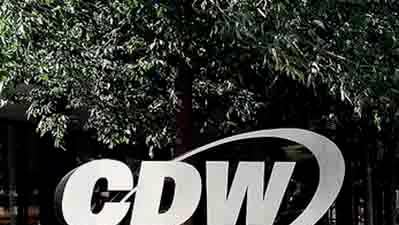Karl Soderlund On Palo Alto Networks' Channel DNA And Why The Company's CEO, President Are Not Trying To 'Force A Google Culture'

Changing Faces
Palo Alto Networks Senior Vice President of Worldwide Channels Karl Soderlund has been the one constant for channel partners over the past year as the company brought in a new CEO and a new president with deep experience at Google as well as a new channel leader in the Americas.
CRN spoke with Soderlund, who joined the company as Americas Channel Chief in May 2017, about channel changes at the company, including new incentives to sell the full portfolio.
CRN also asked the global channel chief about a new Saas Deal Referral channel program that some partners see as a major shift in channel strategy.
He also spoke about how former Google executive and now Palo Alto Networks CEO Nikesh Arora views the channel.

Are there pieces of the operation around cloud and SaaS that are shifting to more of a direct sales model?
Since the inception of this company, we've been channel-centric. It's in our DNA, and that DNA is really not changing. We're always listening to our customers, we're evolving our market approach based on their needs, and we're looking to say, 'How can we accelerate our growth? How can we meet their needs? And how can we incorporate the partners at the same time?' Independent of what our go-to-market strategy is, our partners will always have an important role to play, and we are committed to them moving forward.
What are you hearing from your customers, and how are you evolving your market approach?
What we're hearing from our customers is how they buy, consumption models are changing, what they have for staffing and their needs for support are changing. The rapid change in what the security manufacturers are producing and what they need to support their infrastructure is changing. So we need to be flexible, and we need to be fast. We need to move with them, at the speed of the cloud. We can't be a laggard in this industry. We need to be supporting them, and we need to be having these conversations. One of the things we do a lot is we speak with our customers in customer advisory boards, we speak w/ partners in partner advisory councils, we have global distribution summits. We're constantly looking for feedback in what they're hearing and what they're seeing in order to build the model that will be successful.

What do changes in how customers want to procure cloud mean for your channel partners?
One of things we've always prided ourselves on at Palo Alto Networks is listening to our customers and understanding and meeting our customers needs. And from the inception of this company, we have been a channel-centric company to the point where over 99 percent of our business goes and procures through channel partners on a global basis. We're looking to our customers, we're looking to our partners, we're looking to our distributors. This market is evolving fast. Their needs are changing, their buying consumption patterns are changing. The needs within each industry are charging, and security moves faster arguably than any other technology within the marketplace right now. There's an incredible shortage of IT headcount within our customer base. They need help, and that help is from the partner community. For someone like myself who's been in this industry for 20 years supporting and around the partner community, I've never seen the need for partners greater than it is today. We're looking to build a partner program and model that supports the needs of our customers, while leveraging our strong, best-in-class partner community that we have today.

Are there circumstances in which your direct salesforce can give customers what they need more effectively than channel partners? If so, what are they?
Our salesforce is a high-touch salesforce. They call on end users, they really look to meet the needs of the end users. When you say direct salesforce, being an old guy like I am, I always think of the old days of an IBM where you truly had a direct-selling salesforce. We're a high-touch salesforce. And a high-touch salesforce needs to listen to the customers needs that are out there and their changing needs. And those changing needs are based on flexibility and speed. And that's what we're looking to build this model around.

In order to deliver that flexibility and speed, are there certain pieces or components where going forward the channel partner is going to have a smaller role?
Just the opposite. We look at it as the channel partners are going to have an enhanced role because of those needs, because of what we're looking to do. Because with that flexibility, if you think about having to change at the rate they need to change, they don't have the staff to do it, they don't have the experience to do it, they don't have the wherewithal for the most part. So what they look for is partners with a skillset to come in and provide that direction, whether its advisory to give them direction on what they need, whether its helping them deploy it, or whether its helping them manage it. The opportunity for our partner community is larger than it's ever been. And that's what excites me, and that's why I'm in this role, is really to look at how we can continue to enhance that.

What do partners need to know about what their role is going to be in cloud and SaaS sales and renewals and the potential for change there?
I'm not telling partners anything. I'm listening to partners and what their concerns are. I think it's something that we look at in the business. I think that we are very candid and transparent in saying that we want to listen to our end user community and what they need. In the 12 years of this company, we've always taken that approach from a go-to-market. What are our end users needs, and how do we support them? And the great news is from Day 1, the channel has been a vital part of that, and it's going to continue to be a vital part of that. It's a great opportunity if you look at the three-legged stool of the end user, of Palo Alto Networks, and of the partner community working together to determine how to best do this.

How has the channel strategy changed with having new people in the CEO and the president role?
It really hasn't changed. It's been fairly consistent. One of the things that both Amit [Singh, who started as president in October] and Nikesh [Arora, who started as CEO in June] realize is the power of the channel and the alignment of the channel we have, and how vital they are to our go-to-market. They've both been heavily invested in meeting with our channel partners at the most senior level and understanding what they're seeing in the market. And again, looking at it as that three-legged stool to make sure they're understanding. Because if you just speak to customers, you get a singular point of view. Or if we just speak to our sales team or our internal folks, you get a singular point of view. But when you speak to all three, we triangulate, and we do what's best for the marketplace. They're incredibly quick students of the industry for non-traditional security backgrounds to get an understanding of where we're going and what we want to do as a company and the growth opportunities and the opportunity for our partners. It's been an amazing process the last six months.

Is Palo Alto Networks going to go the way of Google where it's more of a self-service model for customers given Nikesh and Amit's background?
That's not a fair comparison. If you look at Google, for the most part, it’s a B2C business, it's not a B2B business. As we go in and sell into the enterprise, there's different needs and different go-to-market. And they don't come in with any preconceived notions on how to do things best, they're not trying to force a Google culture into this company, and they're going in with open minds. And they're incredibly smart and students of the industry, and now they're getting up to speed. I think there are some concerns, but everyone who meets with them walks away feeling really positive about the direction, and wants to reinforce their commitment to the company and where they go.

What are the concerns, and how have Nikesh and Amit been able to address them?
I think the concerns are, 'You come from a B2C company, are you going to have awareness of how to best support and manage in the enterprise?' 'You don't have a pure security pedigree, and you haven't been in the industry for 25 years.' I think once you hear them speak and you realize how sharp they are and how excited they are, they retire those concerns. I think it's things like that are just really natural and human nature that we would all have. But it's part of the ever-changing industry that we're in. And I look at it from a different mind. I turn it upside down. Would we rather be changing and bringing in some of the best and brightest minds in the industry to look at how we move this company forward and work with our partners? Or would we rather be static and keeping things the way they are and letting the industry move by us? And we're not letting the industry move by us.
Is cloud the future for Palo Alto Networks given the executives you brought in and the acquisitions you made last year?
We have been aggressive in the cloud marketplace making acquisitions, but we're aggressive in the space of meeting our customers needs. We've also made an acquisition in endpoint with Secdo and what we're doing there, and we're continuing to look in the market and you'll see organic growth and inorganic growth from our company as we move forward. These are exciting times, and we need to meet the needs of our customers.

Why was Anar Desai selected for the Americas channel chief position despite not having a security background?
Anar Desai was not traditional security, but he is from the technology space. And it's amazing, when you look at the overlap of partners that Nutanix has and Palo Alto Networks has, it's a pretty heavy overlap. And what he came with is an incredible rolodex of relationships and reputation and integrity within our partner community. He already came in as a trusted advisor for our partners. So he's been able to hit the ground running in the short time he's been here.

To what extent are you incentivizing for partners to sell across the network, the endpoint, and the cloud?
As we revamp the foundation of this program and the model and look at not only a volume commitment but what the value commitment is. The value is to look across all areas of the market. And again, whether it be cloud-based, whether it be network-based, whether it be endpoint-based, we are incenting them in the right way by giving them an ability to boost their margins to sell this technology and align them to it. And that's aligned to the way our salesforce is measured. I think we're one of the few companies that aligns their partner program with their salesforce compensation to make sure there's a unified approach of how we go to market.
What do the margins look like if they're selling one piece of the portfolio versus all of the pieces of the portfolio?
I'm not privy to go into the details of the exact margins. As you can imagine, being two-tier distribution and being a global company, there is some flexibility in how that works. If you go and you sell a traditional resale of firewall only, and then if you look at what if you sold firewall with the complementary technologies within the endpoint and cloud and wrapped services around that, which is a very big component, it's 4X to 5X the profitability they can get by looking at selling the complete solution with services versus just resale of a firewall alone.

Do the enhancements being announced here provide a greater incentive for selling with full platform with services?
There's an awareness that the opportunity for the partner has been there, and if they execute well, they have the opportunity to make more margins. But what hasn’t been in place is, from Palo Alto Networks' standpoint, do we have the infrastructure to support that? From a services standpoint, if we look at advisory services, deployment services, managed services, are we giving them the resources and tools? Do they have the reference architecture? Are we making it easier to actually build out these practices versus just them having an awareness that there's a need there? For our technology and our solutions, whether it be software or hardware, are we enabling them the right way? Are we giving them the awareness? Are we going to market, marketing to the end user community together to give them the opportunity? I think we all had awareness that they could make more margins by wrapping in and selling a compete solution, but it wasn't a repeatable process. But now the program allows it to be a repeatable process across all partners. They now all have an opportunity to do this.
What do you mean by repeatable process?
It's at a program level. So it's not a specific deal, a one-off deal where you pull everything together and say 'wow, these margins are great.' It's at a program level that's showing them how they can actually drive these margins.

What does this emphasis mean for fulfillment partners that have a lot of volume like a CDW or a SHI?
Candidly, we don't have partners that we look to as fulfillment partners. And without going into details, even the partners you're referring to right now are some of the most valuable partners who drive some of the best services opportunities. So what I am seeing across the globe is the partners driving the most volume are the ones who want to enhance themselves are drive the best solution, wrapping services around it. So they're looking to do more and more. So by no means is anyone looking at this and saying 'boy, am I being left behind.' Everyone's looking at it and saying 'wow, I really have an opportunity to execute and make more.' And that's something that has been different than in the past. In the past, whether you added an incredible amount of value or limited value, the margins threshold was very much built in the same range. And now we're really differentiating, and our largest partners are the ones with the biggest appetite to do more with us.

Which partners have access to greater margins now, and what allows them to have the opportunity?
If you look at the overall program, traditionally how it was set up in our PaaS program was that discounts were based on volume alone. Now what we're going to is a combination of volume and value. And value is defined at do the have the technical and sales competency? Do they have the resources? Do they have the services capabilities that are out there? So we're really looking at starting with the end users needs, and how we allow our partners to go about a model where they can meet those needs, and how we support them through that process.

What changes have you made around streamlining the program levels and tiering the program structure?
We've gone from four program levels to three. And with that, we've consolidated our lowest two levels that were initially silver and gold into an innovator. What we're trying to look at is how we support these folks, and what type of resources and assets they have as well as coverage model when they do that. And with that, they'll have tiered discounts based on your level. And those will be based on not only the traditional volume, but also the value that they bring to the table. And value can be defined again as alignment to the technologies, it can be defined as having sales and engineering capabilities to support the end users. And then lastly, we're also, for the first time, introducing a rebate to our largest partners, to our diamond partners. And this is the result of direct feedback from our partner community as something that they need in order to be successful so they can have some profitability to reinvest into Palo Alto Networks and to grow more.
What's the size of the rebate, and how do diamond partners qualify for it?
Qualification is based on meeting certain criteria, and the rebate varies based on theater, without going into details. We look at is saying it's a good opportunity to listen to our partners and provide what they need. And the ones that we reviewed with within our partner advisory councils have been very excited about the opportunity.

What type of criteria are you looking at to determine who qualifies for the rebate?
There's some flexibility in the criteria. Initially what it's going to be is there will be a volume component there, and then there will be, 'Are they selling complementary technologies? So are we looking at the endpoint and are we looking at the cloud-based technologies, as well as the firewall?' The idea here is to put together an achievable goal that we can work together and align with our strategy, and candidly align with our salesforce. This is how our salesforce is thinking about their go-to-market right now and solving the customers' needs. Because it all starts with the customer. The customers need a complete solution. It's not about just having a point product. The complexity of when you sell a point product in the endpoint, a point product in the network, and a point product in the cloud is 'how do they interoperate together? How do they support? Are there gaps in the security posture?' So now what we're saying is, 'here's a complete solution that's end to end, that can provide that, and then partners can wrap services around all of that.'

How well do you feel partners are aligned with the Palo Alto Networks strategy today?
I would say we're very well aligned. I don't think there are any areas of misalignment. There's just opportunities for greater alignment as we move forward. So if you think about it, there's three areas within an IT infrastructure that need to be secure. There's your network security, there's your endpoint security, and there's your cloud security, whether that be the applications themselves or on the public cloud side. When this company came to fruition 12 years ago, what we really focused on was network security. Coming out with the next-gen firewall that was best in class. And since then, what we've evolved to is we provide incredible solutions for an endpoint, and we believe we have the best cloud security in the marketplace right now. So for us, it's more about 'how do we educate our partners and make them aware of the opportunity?' Because sometimes, there's so much that they need to sell, and they sell not only security, but they sell different technologies. So how are they aware of the opportunity that's on the table not only for them to grow, but also to be of greater value to the end user by truly protecting their environment?

How will the introduction of value to the PaaS program change how partners are tiered and what type of discount they get?
Sometimes when people make changes to their program, it's just incredibly disruptive, and it really confuses the partner community. So what we did is we looked at our partners, and we worked very closely with them in building out this program. I'm actually honored to say that this program is their program. We went through multiple revisions of this, asked for feedback, looked for direction, and we really just continued to tweak and enhance it based on their feedback. So what we're looking at right now is a program where the baseline of our currently program is not really disrupted in terms of where we're going. What we're offering is enhancements to grow and do more with us. But if a partner is a baseline partner and they want to continue to drive and work with us in the way they do today, they can. There's not going to be a downside, and there's not going to be a negative effect or a confusing effect in the marketplace. But we're not starting from scratch with this program. We want to leverage the skills that they have today, understand about us, and then give them more opportunities to grow.

What do partners need to do to take advantage of these opportunities?
It's about technology alignment. It's not just selling in the network, but how do make sure that the endpoint is protected and the cloud is protected? It's expanding the technology scope. And with that, are we taking advantage of a services opportunity, whether it be advisory, deployment or managed? It's there. It's somewhat of an a la carte menu. There are certain area they want to focus in, and we're going to give them that opportunity to have the resources there and assets there to take advantage of. We're not pushing them in any one direction. They may have some incredible skills, and an incredible customer base that they're supporting. All we want to do is support them more, and give them more opportunities to grow. We're not forcing them to say 'you must sell our complete product line. You must sell our branded services.' It's not that at all. We're really just trying to be good consultants, stewards of the industry, to allow them to grow.

What's the most significant thing for partners to know about the enhancements you're making?
What we're announcing on Feb. 4 is some enhancements to our NextWave Partner Program. So you can look at it as revamping some of the tools that we have to allow our partners be more successful and meet our customers needs. So there are three main areas we're focusing on in this announcement. One is partner profitability. We're streamlining our program levels, we're tiering our discount structures, we're rolling out more enablement tools and resources for our partners, and we're putting out incentives to really allow them to boost margins. So the partners that are aligned with our strategy and driving are going to have an opportunity to make more margin than they ever have in the past with us. That's number one.

What other improvements can partners expect to see?
Number two, which is a handshake or complement to number one, is services. When we think of services, we think of a services lifecycle, whether it's assessment services on the front end, whether it's deployment services after the sale, or whether it's a full-blown suite of managed services. We're having a complete service offering kit that we're offering our partners to work with them on. We'll have the resources there, we'll have the access there, we'll have the reference architecture there. We the industry need these partners to deliver these best-in-class services to the industry to protect them and give them the best protection possible in the marketplace. And then number three, which is a little bit of an umbrella over number one and two, when you look at the operations side of it, how do we provide new systems, new processes, automation for our partner community to work with us? Because we're no longer just a single product company. We're multiple products, across multiple divisions, with a really elegant solution. But we still need to keep it simple for our partners, and need it to be really easy to work with. So we're being really critical on ourselves internally to say 'how can we make sure we're easy to work with internally within our partner community?' And they can continue to scale and grow with us.
What's the biggest thing you want partners to know given the changes that have taken place?
We're listening to them. We respect and hold their opinion in the highest regards, and we'll continue to be channel-centric moving forward. And the opportunity is bigger than it's ever been in the past for them. And that's a message I'm pretty consistent with. And when we sit down and talk, I don't feel like I'm selling as much as we're having good open dialogue about what we're seeing and how we can work better together. And it's a great space now.